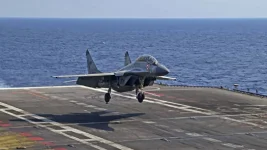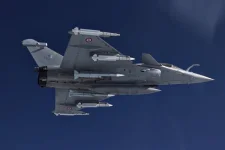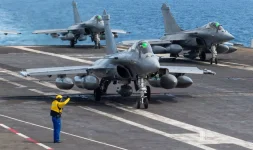- Views: 2K
- Replies: 17
The Indian Navy's plan to acquire 26 Rafale-M fighter jets has moved forward significantly with approval from the Cabinet Committee on Security (CCS). This decision aims to enhance the Navy's aircraft carrier capabilities.
However, industry experts anticipate that the first of these French-made jets will not arrive before late 2030, even if the purchase agreement is signed in the coming months. Production limitations and existing orders at Dassault Aviation in France mean the Navy faces a considerable wait to replace its current fleet of ageing MiG-29K aircraft.
Formal approval for the purchase was granted by the CCS in early April 2025. This clears the path for finalising a government-to-government deal with France, valued at more than ₹50,000 crore (approximately $6 billion).
The Rafale-M is the naval version of the Rafale fighter already operated by the Indian Air Force (IAF) and is specifically designed for use on aircraft carriers like INS Vikramaditya and the domestically built INS Vikrant. Key features include advanced electronics, a stronger landing gear for carrier operations, and the ability to take off using a ski-jump ramp and land using arresting wires, boosting the Navy's air defence and attack power in the Indian Ocean Region.
Despite the need to replace the MiG-29K fleet, known for maintenance challenges and accidents, the delivery schedule is dictated by Dassault Aviation's manufacturing capacity. The company's facility near Bordeaux currently produces between 11 and 14 Rafale jets per year. This output must cover commitments to the French military, existing export clients such as Egypt and Qatar.
Production backlogs, worsened by global supply chain disruptions following the COVID-19 pandemic and rising international demand, leave limited room for new orders. "The first lot will be handed over only in 2030," a source involved in the discussions informed ANI, adding that finalising the deal quickly, even by June 2025, would not change this timeline.
The Indian Navy's order comprises 22 single-seat Rafale-M fighters and four twin-seat trainer versions. Fulfilling this requires Dassault either to increase its production rate or reallocate existing production slots, both presenting difficulties. France's own military requirements, including a recent order for 42 more Rafales placed in 2023, receive priority.
Furthermore, large export orders for Indonesia (42 jets) and potentially the UAE (80 jets) add to the production queue. Public frustration over the wait time has been noted, with some expressing concern online about the condition of the existing MiG-29Ks.
Negotiations between India and France are expected to conclude by mid-2025. These talks will settle the final price, offset arrangements (investments in India's defence sector), and any specific modifications required for India, similar to the IAF's Rafale deal which included advanced Meteor and SCALP missiles.
It is anticipated that the Navy's Rafale-Ms will incorporate Indian systems like the Astra air-to-air missile and components of the Uttam radar, with Hindustan Aeronautics Limited (HAL) handling maintenance within India. However, the production delay means the Navy must continue operating its fleet of around 40 MiG-29Ks, of which often only about half are available due to engine problems and difficulty obtaining spare parts.
The Rafale-M was selected over the American F/A-18 Super Hornet primarily due to its established record operating from aircraft carriers (used by the French Navy since 2004) and the logistical benefits of sharing a platform commonality with the IAF's Rafale fleet.
With an operational range exceeding 1,000 kilometres and the capacity to carry 9.5 tonnes of weapons and fuel, the Rafale-M represents a significant upgrade over the MiG-29K.
This acquisition is seen as crucial for enabling the Indian Navy to effectively monitor and counter the increasing naval activities of China and other powers within the vital Indian Ocean Region.



